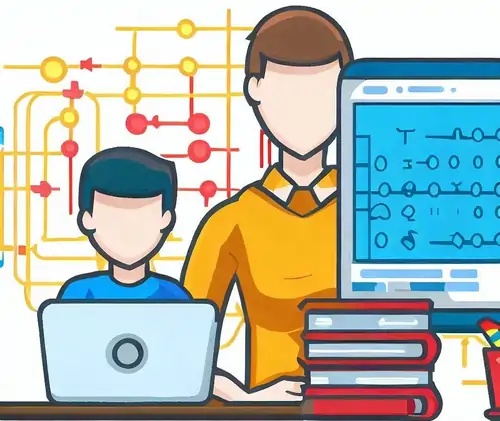Error Control Coding in Communication Systems: A MATLAB-based Guide to University Assignment Success

Data transmission that is reliable is crucial in modern communication systems. Data corruption and system performance can result from errors that can occur during data transmission over noisy channels. Techniques for error control coding, provided by a Matlab Assignment Expert, are used to address this problem. These methods increase the transmitted data's redundancy, enabling the receiver to find and fix mistakes and preserving the message's integrity.
For those seeking further insight into assistance with communication system assignments, delve into our blog where we explore the significance of error control coding within communication systems. The wide range of tools and functions that MATLAB offers for error control coding makes it the perfect tool for academic study and practical applications.
Fundamentals of Error Control Coding
To make error detection and correction easier, error control coding entails supplementing the original data stream with additional bits. The following are the top three types of error control codes:

1. Block Codes
Block codes separate the data stream into units of a fixed size before adding redundant bits to each unit. These codes are easy to use and very effective at detecting errors. The Hamming code is one of the most popular block codes.
A linear error-correcting code called the Hamming code can identify and correct single-bit errors as well as some two-bit errors. The fundamental principle of Hamming codes is to systematically add parity bits to the data stream at predetermined locations.
Students must define the generator matrix and the parity-check matrix in order to implement the Hamming code in MATLAB. Then, to carry out encoding and decoding operations, MATLAB functions like encoding and decoding from the Communications System Toolbox can be used.
2. Convolutional Codes
Contrarily, convolutional codes encrypt the input stream using a sliding window rather than dividing the data into blocks. As a result, the output is continuous, offering a higher coding gain than block codes. Convolutional codes are frequently decoded using the Viterbi algorithm, which then restores the original data.
The Communications System Toolbox in MATLAB provides tools for designing and simulating convolutional codes. To see how different code rates, constraint lengths, and generator polynomials affect error correction capabilities, students can experiment with these variables.
For instance, students can use the convenc and vitdec functions to encode and decode data, respectively, after first creating a trellis structure for a particular convolutional code using the poly2trellis function.
3. Turbo Codes
Turbo codes, which are iterative codes, have completely changed error control coding. They are widely used in contemporary communication systems and offer performance that is close to the Shannon limit. Turbo codes use iterative decoding and parallel concatenated convolutional codes to improve their error-correcting capabilities.
Compared to block codes and convolutional codes, turbo codes have more complicated encoders and decoders. However, MATLAB provides libraries and built-in functions that make it simple to design and simulate turbo codes.
Students can specify the trellis structure for the individual convolutional codes using the trel (trellis) object in MATLAB, and then use the turbo encoder and turbo decode functions to encode and decode the data.
MATLAB Approaches for Implementing Error Control Coding
To make the application and analysis of error control coding techniques easier, MATLAB provides a number of tools and functions. Some of the most effective MATLAB strategies for passing university assignments are listed below:
1. Communications System Toolbox
The Communications System Toolbox in MATLAB is a useful tool for simulating error control coding. It offers tools for creating, simulating, and assessing various coding schemes. Students have access to functions for various codes' encoding, decoding, and BER/FER analyses. This toolbox makes it easier to put error control coding algorithms into practice, allowing students to concentrate on understanding the theoretical ideas and evaluating the effectiveness of various coding techniques.
The toolbox also has modeling tools for AWGN (Additive White Gaussian Noise), fading, and multipath propagation, among other communication channel impairments. These channel models can be incorporated by students into their simulations to see how various error control codes behave in real-world communication scenarios.
2. Custom Code Implementations
Implementing error control codes from scratch can help students better understand the underlying ideas when used for educational purposes. Students can create custom code implementations of block codes, convolutional codes, and turbo codes using MATLAB because of its mathematical capabilities and ease of use.
Students learn how redundancy is added, errors are detected, and corrections are made by putting these codes' encoding and decoding algorithms into practice. Students can also see how different code parameters affect performance thanks to MATLAB's visualization features, which helps them understand the trade-offs involved in error control coding.
For instance, using the Viterbi algorithm, students can develop MATLAB functions for encoding and decoding the Hamming code or the convolutional code. Their practical experience not only improves their coding abilities but also solidifies their comprehension of the fundamental ideas behind error control coding.
3. BER Analysis and Performance Evaluation
Students can evaluate the effectiveness of error control coding schemes using metrics like Bit Error Rate (BER) and Frame Error Rate (FER) using MATLAB. Students can examine the coding gain achieved by various error control codes and compare their performance by simulating a coded communication system and adding noise to the channel.
Plotting functions in MATLAB make it easier to see BER and FER curves, allowing students to examine error performance in various channel situations. They can weigh the trade-offs between complexity and performance by comparing the error rates of various coding schemes.
Students can also research how various decoding algorithms affect overall performance. For convolutional codes or turbo codes, for instance, they can contrast the effectiveness of hard-decision decoding and soft-decision decoding.
Applications of Error Control Coding in Communication Systems
Many communication systems use error control coding to ensure reliable data transmission over noisy channels. Some of the well-known applications are listed below:
1. Wireless Communication
Environmental variables and interference can introduce errors during data transmission in wireless communication systems. Error control coding methods make sure that the recipient receives error-free data, enhancing the caliber of voice and video calls as well as the wireless networks' throughput.
Students can use MATLAB to simulate wireless communication channels with various signal-to-noise ratios (SNR) and watch how various error control codes behave under various SNR circumstances. Students are better able to understand the significance of error control coding in ensuring reliable wireless communication thanks to this practical insight.
2. Satellite Communication
The long-distance transmission used in satellite communication exposes the signal to noise and distortion. Satellite systems can ensure accurate data delivery through the use of error control coding, allowing seamless communication between ground stations and satellites.
Students can evaluate the effectiveness of various coding techniques by modeling satellite communication links in MATLAB while taking into account various channel impairments. Through this exercise, they acquire the skills needed to develop communication systems that are error-tolerant for satellite-based applications.
3. Data Storage
Error control coding is essential in data storage devices like flash memory and hard drives. In order to find and fix errors that might happen during data retrieval, these systems use coding techniques, which improve the dependability and longevity of storage devices.
With and without error control coding, students can simulate data storage and retrieval processes in MATLAB. They learn more about the function of coding in enhancing data integrity and reliability in storage systems by contrasting the efficacy of various error control codes.
Conclusion
In order to ensure reliable communication in the presence of channel impairments, error control coding is essential. Because of its extensive tool and function set, MATLAB is a great tool for learning and using different error-control coding techniques.
Students can advance the field of communication systems by studying this topic in-depth and creating creative answers to real-world communication problems. University students are given the necessary skills for academic success and future success in the field of communication engineering by combining theoretical knowledge with hands-on MATLAB implementations.
Finally, error control coding is a crucial component of communication engineering, and MATLAB provides a wealth of resources to help students understand its concepts clearly. University students can learn important insights into contemporary communication systems and equip themselves with crucial skills for success in their future academic and professional endeavors by using MATLAB to investigate block codes, convolutional codes, and turbo codes.